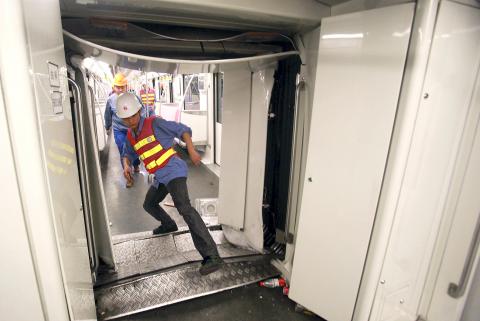Two subway trains collided in central Shanghai yesterday, injuring more than 260 passengers, three critically, prompting renewed public anger just two months after a deadly crash between two high-speed trains.
The collision occurred near the Yu Yuan gardens, a well-known tourist attraction, after a signal failure meant Shanghai Metro Co staff had to direct trains by telephone, state media said.
The company said 500 passengers had been evacuated from the trains and the injured taken to hospital, three of whom were seriously injured.

Photo: AFP
Ambulances rushed to the Yu Yuan station and emergency personnel were seen carrying injured passengers out, witnesses said.
Pictures posted on Chinese Web sites showed bloodied passengers, some lying on the floor apparently unconscious and others with head injuries.
Shen Jun, 23, who was in the first coach of the train that collided at 2:51pm, said: “Blood was everywhere.”

Photo: Reuters
Xinhua news agency said most of the injuries were bruises and bone fractures.
“Today is the darkest day in the history of the Shanghai Metro’s operation,” a news report by Chinese Internet company Sina said, citing the subway operator’s official microblog. “No matter the ultimate cause and responsibility, [we feel] particularly guilty about the harm and losses borne by the public. We will put in our utmost ability to rescue the wounded, resume operations as soon as possible ... and cooperate with the relevant departments in the investigation”
“Even if our apologies pale in comparison to the actual injuries, we are deeply sorry,” the report said.
However, the statement on Sina Weibo was later removed. It was unclear why.
The Shanghai crash quickly became the most talked about topic on the Sina Weibo service. The line on which the accident occurred opened only last year, part of the cosmopolitan business hub’s ambitious subway expansion plans.
“Another accident — what a joke. So much money has been spent, all they’ve built is crap,” “ggirl” wrote.
The accident follows a collision between two bullet trains in eastern China in July that killed 40 people, which triggered public fury at the government’s perceived slow response and accusations of a cover-up.
Caixi, a Chinese-language magazine, reported on its Web site that the signals used on the Shanghai subway were made by China Railway Signal and Communication Corp, the same firm that was blamed for the faulty signals in the July crash.
In other developments, a train passenger was beaten to death by staff on a train in eastern China, state media reported. Three train staff seized the middle-aged man by the throat and savagely beat him after he intervened in an argument involving another passenger, Jiangxi Television reported on Monday.
Doctors were summoned from an emergency center near the station in Jiangxi Province where the train stopped, but the man died before they arrived, the report said, citing witnesses and the hospital.

SECURITY: As China is ‘reshaping’ Hong Kong’s population, Taiwan must raise the eligibility threshold for applications from Hong Kongers, Chiu Chui-cheng said When Hong Kong and Macau citizens apply for residency in Taiwan, it would be under a new category that includes a “national security observation period,” Mainland Affairs Council (MAC) Minister Chiu Chui-cheng (邱垂正) said yesterday. President William Lai (賴清德) on March 13 announced 17 strategies to counter China’s aggression toward Taiwan, including incorporating national security considerations into the review process for residency applications from Hong Kong and Macau citizens. The situation in Hong Kong is constantly changing, Chiu said to media yesterday on the sidelines of the Taipei Technology Run hosted by the Taipei Neihu Technology Park Development Association. With

CARROT AND STICK: While unrelenting in its military threats, China attracted nearly 40,000 Taiwanese to over 400 business events last year Nearly 40,000 Taiwanese last year joined industry events in China, such as conferences and trade fairs, supported by the Chinese government, a study showed yesterday, as Beijing ramps up a charm offensive toward Taipei alongside military pressure. China has long taken a carrot-and-stick approach to Taiwan, threatening it with the prospect of military action while reaching out to those it believes are amenable to Beijing’s point of view. Taiwanese security officials are wary of what they see as Beijing’s influence campaigns to sway public opinion after Taipei and Beijing gradually resumed travel links halted by the COVID-19 pandemic, but the scale of

A US Marine Corps regiment equipped with Naval Strike Missiles (NSM) is set to participate in the upcoming Balikatan 25 exercise in the Luzon Strait, marking the system’s first-ever deployment in the Philippines. US and Philippine officials have separately confirmed that the Navy Marine Expeditionary Ship Interdiction System (NMESIS) — the mobile launch platform for the Naval Strike Missile — would take part in the joint exercise. The missiles are being deployed to “a strategic first island chain chokepoint” in the waters between Taiwan proper and the Philippines, US-based Naval News reported. “The Luzon Strait and Bashi Channel represent a critical access

Pope Francis is be laid to rest on Saturday after lying in state for three days in St Peter’s Basilica, where the faithful are expected to flock to pay their respects to history’s first Latin American pontiff. The cardinals met yesterday in the Vatican’s synod hall to chart the next steps before a conclave begins to choose Francis’ successor, as condolences poured in from around the world. According to current norms, the conclave must begin between May 5 and 10. The cardinals set the funeral for Saturday at 10am in St Peter’s Square, to be celebrated by the dean of the College